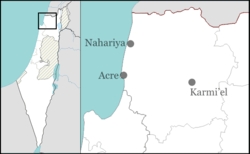Eshhar
| Eshhar אֶשְׁחָר | |
|---|---|
| Hebrew transcription(s) | |
| • unofficial | = Eshchar |
|
| |
 Eshhar | |
| Coordinates: 32°53′5.52″N 35°18′4.85″E / 32.8848667°N 35.3013472°ECoordinates: 32°53′5.52″N 35°18′4.85″E / 32.8848667°N 35.3013472°E | |
| District | Northern |
| Council | Misgav |
| Affiliation | HaMerkaz HaHakla'i |
| Founded | 1986 |
| Founded by | American Jews |
| Population (2015)[1] | 790 |
| Name meaning | Rhamnus palaestinus |
Eshhar (Hebrew: אֶשְׁחָר) is a communal settlement in northern Israel. Located in the Galilee to the south of Karmiel and north of Sakhnin, it falls under the jurisdiction of Misgav Regional Council. In 2015 it had a population of 790. It is adjacent to the Bedouin village of Arab al-Na'im, with which it shares an access road.
History
In 1979, a group of Jews in Chicago came up with a plan to establish a joint secular-religious community in Israel. Eshhar was established in 1986 by a gar'in comprising this group and other English-speaking and Israeli families.[2][3]
The community was named for the Rhamnus palaestinus (buckthorn), "eshhar" in Hebrew. Residents avoid driving within the village on Shabbat and public events are kosher. Beyond this, residents define their own lifestyles, without coercion.
The local Tzofim scout group is open to both religious and secular youth.[4]
Plans for a pluralistic Meguvan-affiliated elementary school failed due to legal issues and opposition from the Ministry of Education and the Regional Council. An attempt to establish such a school in Moreshet failed for similar reasons.[5] Children attend local religious or secular schools instead.
Relations with the adjacent hillside Bedouin village of Arab al-Na'im are generally good, based on a firm footing established in initial meetings between the councils of the two villages in the 1990s, when it was agreed that "good neighborly relations" would be a pragmatic and helpful arrangement. Eshhar as a community, along with other Jewish organizations, have been involved in supporting Arab al-Na'im's leaders in obtaining state recognition and, subsequently, connection to municipal services and the institution of a master plan for the village, enabling the first permanent masonry-built houses to be constructed there in 2014.[6]
Facilities
Facilities in the village include a new synagogue and community hall opened in 2014, a mikveh, a small petting zoo, a library, outdoor sports facilities and playgrounds, a community pub and a community orchard. There is a nursery for children from the age of three months to three years, and three kindergartens.
A third neighborhood is under construction as of 2015. There are plans for a further expansion (shlav dalet) after that.[7]
References
- ↑ "List of localities, in Alphabetical order" (PDF). Israel Central Bureau of Statistics. Retrieved 16 October 2016.
- ↑ "בית יגאל אלון. מוזיאון ומרכז חינוכי - אדם בגליל, מאגר מידע - ישובים אשחר". Bet-alon.co.il. Retrieved 2015-11-01.
- ↑ "מועצה אזורית משגב | לכל היומנים-אומרים שהיה פה". Blogs.misgav.org.il. 2002-12-28. Retrieved 2015-11-01.
- ↑ Youth Movement Village website
- ↑ Pluralistic School in Misgav Town Vetoed at 11th Hour Haaretz, 31 August 2011
- ↑ "ישראל נאמן | Lectures, Articles, Tours: Israel | Mideast onTarget | Elliot Chodoff & Yisrael Ne'eman | Co-Existence: Failed Term - Failed Policy". Me-ontarget.org. Retrieved 2015-11-01.
- ↑ "הרחבה - אשחר ישוב קהילתי במשגב". Eshchar.co.il. Retrieved 2015-11-01.
External links
- Official website
- Eshhar page Galilee Development Authority (Hebrew)
- Eshhar page Misgav Regional Council (Hebrew)